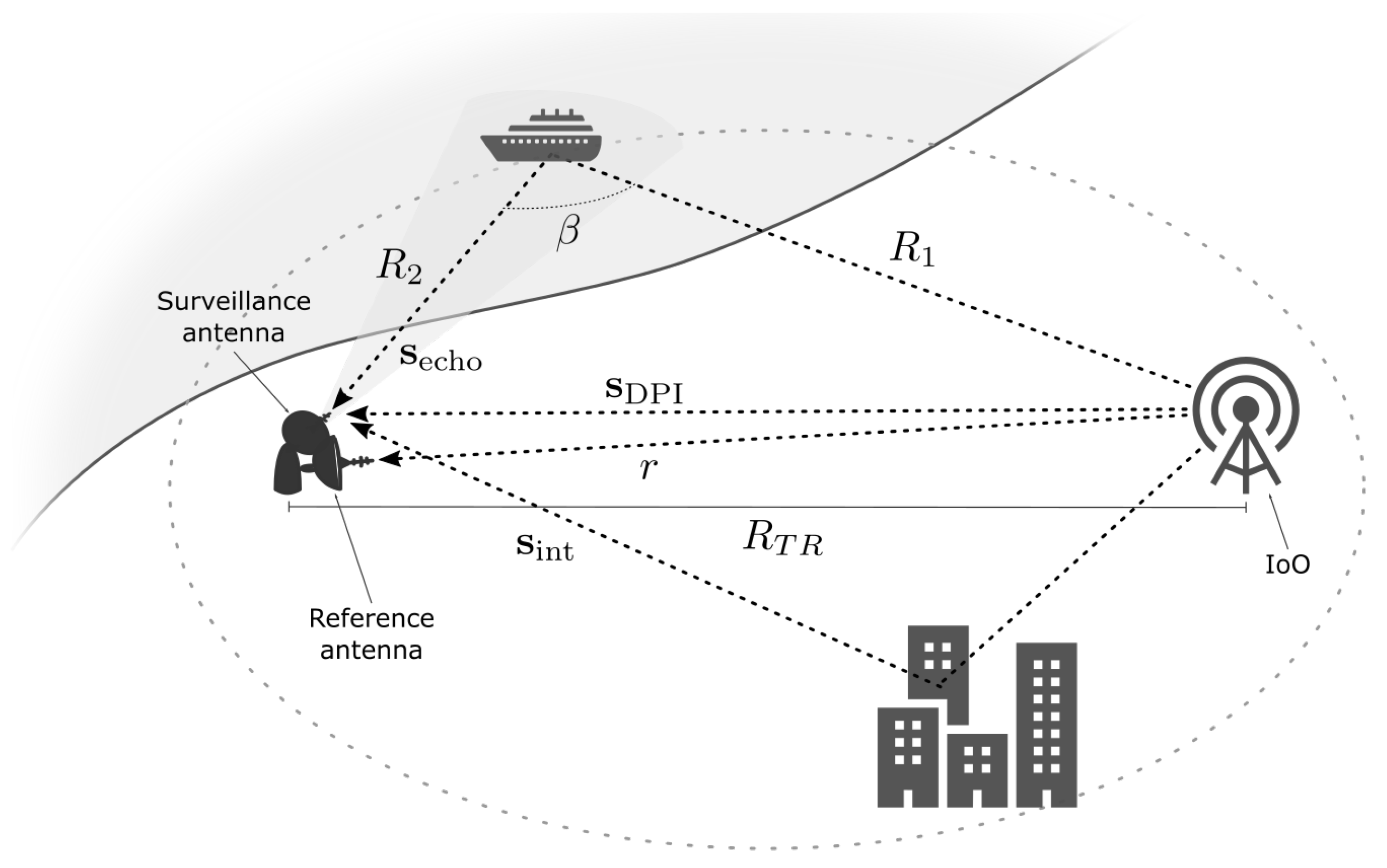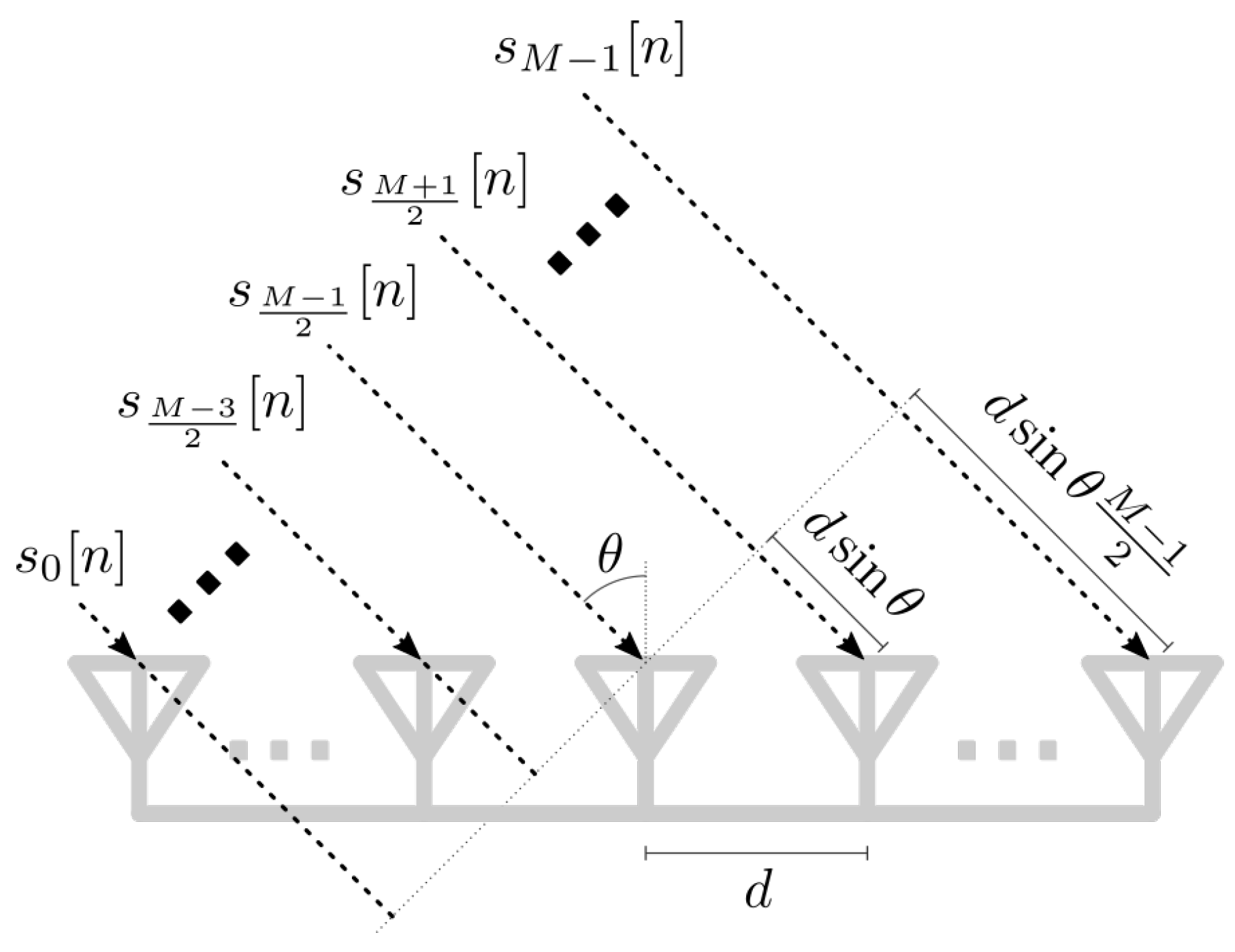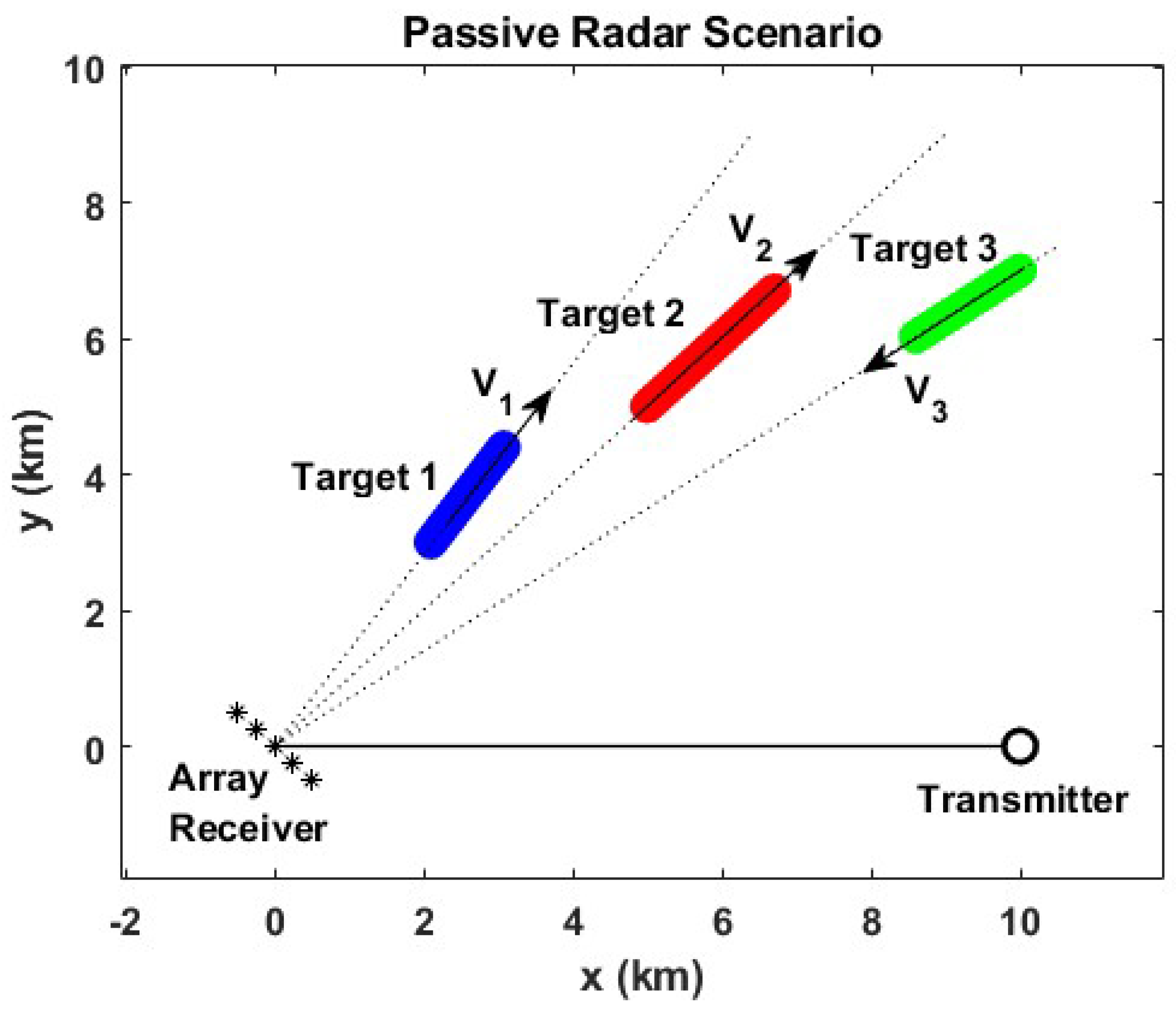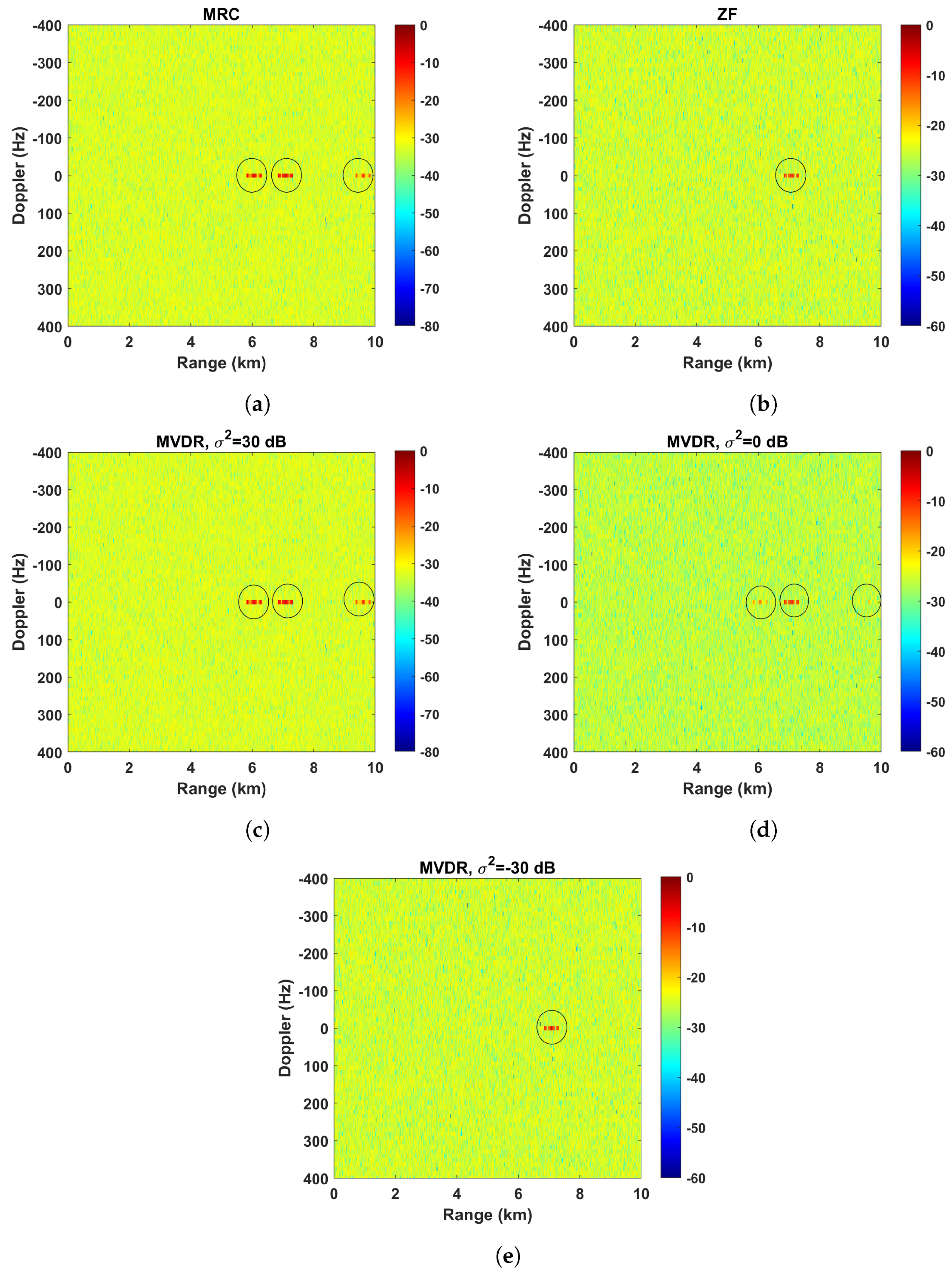Beamforming Techniques for Passive Radar: An Overview
Abstract
1. Introduction
1.1. Passive Bistatic Radar Scenario
1.2. Prior Art
2. System Model
2.1. System Performance Metrics
2.2. Main Beamforming Strategies
2.2.1. MRC
2.2.2. MVDR
2.2.3. ZF
3. Beamforming Techniques to Enhance the Surveillance Signal
3.1. Beamforming before the CAF
Asymptotic Regime
3.2. Beamforming after the CAF
3.3. Discussion
- Target detection and parameter estimation are more manageable in the range–Doppler domain. As already said, when the DoA estimation is performed in the angular domain, it is easier to miss the estimation of the target if its angular direction is similar to that of a strong interference source. In spite of this, obtaining the covariance matrices in the range–Doppler domain also has a downside. Indeed, the sample covariance matrices obtained with this method have to be computed with an adequate sample size to fulfill the full rank condition to avoid numerical problems and to effectively capture the spatial structure of the interference and the noise. The number of samples grows with the number of antennas M, which is inconvenient when moving to large antenna arrays.
- Processing in the range–Doppler domain lacks the flexibility of the angular domain approach. Apart from MVDR, it is not possible to employ other beamforming solutions that estimate the sample covariance matrices because they contain both the interference and the noise, so the ZF strategy is not applicable. This can be easily appreciated in the classification provided in Table 2.
- Regarding the computational complexity, the angular domain can take advantage of the flexibility of using different beamforming designs that might be adapted to different situations. For instance, the MRC is a useful and computationally cheap approach when interference is not strong or the antenna array is adequately orientated to mitigate it. In addition, the computational complexity of the ZF approach is dominated by a matrix inversion of the size of the number of interference sources, which might be very small compared to the number of antenna elements M. On the contrary, MVDR, which is the only option for beamforming in the range–Doppler domain estimating the covariance matrix, performs a matrix inversion of size M. When moving to larger antenna array sizes, this fact, together with the computational load introduced when the CAF is performed for each antenna element, might lead to impractical situations.
- In relation to SINR increase produced by the beamforming operation, we have clearly stated that, under favorable conditions, the SINR achieved with the range–Doppler approach is equal to that obtained with the proper angular directions. Therefore, the scenario of application and, correspondingly, the method employed to accurately obtain the angular spatial information of the setup is a key idea to choosing one approach over the other one.
4. Results and Discussion
4.1. Scenario Description
4.2. Evaluation of the Different Beamforming Strategies
4.3. Range–Doppler Map When Beamforming Is Applied before the CAF
4.4. Range–Doppler Map When Beamforming Is Applied after the CAF
5. Open Issues and Future Research Directions
5.1. Improving the Estimation Accuracy of the Covariance Matrices
5.2. Exploiting Different IoOs to Enhance the Quality of the Reference Channel
5.3. Simultaneous Detection of Multiple Targets
5.4. Combination with Temporal Processing Techniques
5.5. Spherical-Wave Front for Passive Radar
5.6. Integration with Communication Systems
6. Conclusions
Author Contributions
Funding
Institutional Review Board Statement
Informed Consent Statement
Data Availability Statement
Conflicts of Interest
Abbreviations
| AoI | Area of Interest |
| AWGN | Additive White Gaussian Noise |
| CAF | Cross Ambiguity Function |
| CPI | Coherent Processing Interval |
| DAB | Digital Audio Broadcasting |
| DoA | Direction of Arrival |
| DPI | Direct-Path Interference |
| DVB-T | Digital Video Broadcasting–Terrestrial |
| DVB-S | Digital Video Broadcasting–Satellite |
| ECA | Extensive Cancellation Algorithm |
| ECM | Electronic Countermeasures |
| FM | Frequency Modulation |
| GNSS | Global Navigation Satellite System |
| GSM | Global System for Mobile Communications |
| IoO | Illuminator of Opportunity |
| LoS | Line-of-Sight |
| LTE | Long Term Evolution |
| MIMO | Multiple-Input Multiple-Output |
| MVDR | Minimum Variance Distortionless Response |
| mmWave | Millimeter Wave |
| MRC | Maximum Ratio Combining |
| MUSIC | Multiple Signal Classification |
| RIS | Reconfigurable Intelligent Surface |
| STAP | Space-Time Adaptive Processing |
| SINR | Signal-to-Interference-plus-Noise Ratio |
| SNR | Signal-to-Noise Ratio |
| ULA | Uniform Linear Array |
| ZF | Zero-Forcing |
References
- Kuschel, H.; Heckenbach, J.; Muller, S.; Appel, R. On the potentials of passive, multistatic, low frequency radars to counter stealth and detect low flying targets. In Proceedings of the 2008 IEEE Radar Conference, Rome, Italy, 26–30 May 2008; pp. 1–6. [Google Scholar] [CrossRef]
- Knioła, M.; Rogala, T.; Szczepaniak, Z. Counter-Passive Coherent Locator (C-PCL)—A Method of Remote Detection of Passive Radars for Electronic Warfare Systems. Electronics 2021, 10, 1625. [Google Scholar] [CrossRef]
- Kazemi Rad, M.; Andargoli, S.M.H. Power control and beamforming in passive phased array radars for low probability of interception. Digit. Signal Process. 2021, 117, 103165. [Google Scholar] [CrossRef]
- Howland, P.E.; Maksimiuk, D.; Reitsma, G. FM radio based bistatic radar. IEE Proc. Radar Sonar Navig. 2005, 152, 107–115. [Google Scholar] [CrossRef]
- Malanowski, M.; Kulpa, K.; Samczynski, P.; Misiurewicz, J.; Kulpa, J. Long range FM-based passive radar. In Proceedings of the IET International Conference on Radar Systems (Radar 2012), Glasgow, UK, 22–25 October 2012; pp. 1–4. [Google Scholar] [CrossRef]
- Yardley, H.J. Bistatic Radar Based on DAB Ifluminators: The Evolution of a Practical System. IEEE Aerosp. Electron. Syst. Mag. 2007, 22, 13–16. [Google Scholar] [CrossRef]
- Palmer, J.E.; Harms, H.A.; Searle, S.J.; Davis, L. DVB-T Passive Radar Signal Processing. IEEE Trans. Signal Process. 2013, 61, 2116–2126. [Google Scholar] [CrossRef]
- Płotka, M.; Malanowski, M.; Samczyński, P.; Kulpa, K.; Abratkiewicz, K. Passive Bistatic Radar Based on VHF DVB-T Signal. In Proceedings of the 2020 IEEE International Radar Conference (RADAR), Washington, DC, USA, 28–30 April 2020; pp. 596–600. [Google Scholar] [CrossRef]
- Zemmari, R.; Nickel, U.; Wirth, W.D. GSM passive radar for medium range surveillance. In Proceedings of the 2009 European Radar Conference (EuRAD), Rome, Italy, 30 September–2 October 2009; pp. 49–52. [Google Scholar]
- Xu, H.; Wang, H.; Liao, K.; Ouyang, S.; Gong, Y. Spatial Spectrum Estimation of Co-Channel Direct Signal in Passive Radar Based on Coprime Array. Remote Sens. 2022, 14, 5308. [Google Scholar] [CrossRef]
- Bartoletti, S.; Conti, A.; Win, M.Z. Passive radar via LTE signals of opportunity. In Proceedings of the 2014 IEEE International Conference on Communications Workshops (ICC), Sydney, Australia, 10–14 June 2014; pp. 181–185. [Google Scholar] [CrossRef]
- Gomez-del Hoyo, P.; Jarabo-Amores, M.P.; Mata-Moya, D.; del Rey-Maestre, N.; Rosado-Sanz, J. First Approach on Ground Target Detection with GPS based Passive Radar: Experimental Results. In Proceedings of the 2019 Signal Processing Symposium (SPSympo), Krakow, Poland, 17–19 September 2019; pp. 71–75. [Google Scholar] [CrossRef]
- Pastina, D.; Santi, F.; Pieralice, F.; Antoniou, M.; Cherniakov, M. Passive Radar Imaging of Ship Targets With GNSS Signals of Opportunity. IEEE Trans. Geosci. Remote Sens. 2021, 59, 2627–2642. [Google Scholar] [CrossRef]
- Gomez-del Hoyo, P.; del Rey-Maestre, N.; Jarabo-Amores, M.P.; Mata-Moya, D.; Benito-Ortiz, M.d.C. Improved 2D Ground Target Tracking in GPS-Based Passive Radar Scenarios. Sensors 2022, 22, 1724. [Google Scholar] [CrossRef]
- Rosado-Sanz, J.; Jarabo-Amores, M.; Mata-Moya, D.; del Rey-Maestre, N.; Almodóvar-Hernández, A. DVB-S Passive Radar Performance Evaluation in Semi-Urban Ground Scenario. In Proceedings of the 2020 21st International Radar Symposium (IRS), Warsaw, Poland, 5–8 October 2020; pp. 232–235. [Google Scholar] [CrossRef]
- Chetty, K.; Smith, G.E.; Woodbridge, K. Through-the-Wall Sensing of Personnel Using Passive Bistatic WiFi Radar at Standoff Distances. IEEE Trans. Geosci. Remote Sens. 2012, 50, 1218–1226. [Google Scholar] [CrossRef]
- Kanhere, O.; Goyal, S.; Beluri, M.; Rappaport, T.S. Target Localization using Bistatic and Multistatic Radar with 5G NR Waveform. In Proceedings of the 2021 IEEE 93rd Vehicular Technology Conference (VTC2021-Spring), Virtual, 25 April–19 May 2021; pp. 1–7. [Google Scholar] [CrossRef]
- Lyu, X.; Liu, B.; Fan, W. Signal processing in passive radar with multi-user MIMO-OFDM signal. EURASIP J. Adv. Signal Process. 2022, 2022, 113. [Google Scholar] [CrossRef]
- Samczyński, P.; Abratkiewicz, K.; Płotka, M.; Zieliński, T.P.; Wszołek, J.; Hausman, S.; Korbel, P.; Ksieżyk, A. 5G Network-Based Passive Radar. IEEE Trans. Geosci. Remote Sens. 2022, 60, 1–9. [Google Scholar] [CrossRef]
- Malanowski, M.; Kulpa, K. Two Methods for Target Localization in Multistatic Passive Radar. IEEE Trans. Aerosp. Electron. Syst. 2012, 48, 572–580. [Google Scholar] [CrossRef]
- Poveda-García, M.; Gil-Martínez, A.; Salmerón, F.; Gómez-Tornero, J.L. Frequency-Beam-Scanning mm-Wave Antennas for Direction Finding RADAR. In Proceedings of the 2022 19th European Radar Conference (EuRAD), Milan, Italy, 28–30 September 2022; pp. 293–296. [Google Scholar] [CrossRef]
- Schmidt, R. Multiple emitter location and signal parameter estimation. IEEE Trans. Antennas Propag. 1986, 34, 276–280. [Google Scholar] [CrossRef]
- Wang, R.; Wang, Y.; Li, Y.; Cao, W.; Yan, Y. Geometric Algebra-Based ESPRIT Algorithm for DOA Estimation. Sensors 2021, 21, 5933. [Google Scholar] [CrossRef]
- Van Veen, B.; Buckley, K. Beamforming: A versatile approach to spatial filtering. IEEE ASSP Mag. 1988, 5, 4–24. [Google Scholar] [CrossRef]
- Björnson, E.; Bengtsson, M.; Ottersten, B. Optimal Multiuser Transmit Beamforming: A Difficult Problem with a Simple Solution Structure [Lecture Notes]. Signal Process. Mag. IEEE 2014, 31, 142–148. [Google Scholar] [CrossRef]
- Frost, O. An algorithm for linearly constrained adaptive array processing. Proc. IEEE 1972, 60, 926–935. [Google Scholar] [CrossRef]
- Nickel, U. Array Processing for Radar: Achievements and Challenges. Int. J. Antennas Propag. 2013, 2013, 261230. [Google Scholar] [CrossRef]
- Colone, F.; O’Hagan, D.W.; Lombardo, P.; Baker, C.J. A Multistage Processing Algorithm for Disturbance Removal and Target Detection in Passive Bistatic Radar. IEEE Trans. Aerosp. Electron. Syst. 2009, 45, 698–722. [Google Scholar] [CrossRef]
- Fabrizio, G.; Colone, F.; Lombardo, P.; Farina, A. Adaptive beamforming for high-frequency over-the-horizon passive radar. IET Radar Sonar Navig. 2009, 3, 384–405. [Google Scholar] [CrossRef]
- Gu, Y.; Leshem, A. Robust Adaptive Beamforming Based on Interference Covariance Matrix Reconstruction and Steering Vector Estimation. IEEE Trans. Signal Process. 2012, 60, 3881–3885. [Google Scholar] [CrossRef]
- Tao, R.; Wu, H.; Shan, T. Direct-path suppression by spatial filtering in digital television terrestrial broadcasting-based passive radar. IET Radar Sonar Navig. 2010, 4, 791–805. [Google Scholar] [CrossRef]
- Villano, M.; Colone, F.; Lombardo, P. Antenna Array for Passive Radar: Configuration Design and Adaptive Approaches to Disturbance Cancellation. Int. J. Antennas Propag. 2013, 2013, 920639. [Google Scholar] [CrossRef]
- Strøm, K.; Lie-Svendsen, O.; Norheim-Næss, I.; Johnsen, T.; Finden, E.; Olsen, K.E. DSI Suppression with Adaptive Beamforming in DVB-T Passive Radar Measurements. In Proceedings of the 2018 19th International Radar Symposium (IRS), Bonn, Germany, 20–22 June 2018; pp. 1–10. [Google Scholar] [CrossRef]
- Chabriel, G.; Barrère, J. Adaptive Target Detection Techniques for OFDM-Based Passive Radar Exploiting Spatial Diversity. IEEE Trans. Signal Process. 2017, 65, 5873–5884. [Google Scholar] [CrossRef]
- Fabrizio, G.; Frazer, G.; Turley, M. Stap for Clutter and Interference Cancellation in a Hf Radar System. In Proceedings of the 2006 IEEE International Conference on Acoustics Speech and Signal Proceedings, Toulouse, France, 14–19 May 2006; Volume 4, p. 4. [Google Scholar] [CrossRef]
- Fabrizio, G.; Holdsworth, D.; Farina, A. Experimental HF radar trial of real-time STAP. In Proceedings of the 2007 International Waveform Diversity and Design Conference, Pisa, Italy, 4–8 June 2007; pp. 316–320. [Google Scholar] [CrossRef]
- Moscardini, C.; Conti, M.; Berizzi, F.; Martorella, M.; Capria, A. Spatial Adaptive Processing for Passive Bistatic Radar. In Proceedings of the 2014 IEEE Radar Conference, Cincinnati, OH, USA, 19–23 May 2014; pp. 1061–1066. [Google Scholar] [CrossRef]
- Bournaka, G.; Baruzzi, A.; Heckenbach, J.; Kuschel, H. Experimental validation of beamforming techniques for localization of moving target in passive radar. In Proceedings of the 2015 IEEE Radar Conference (RadarCon), Arlington, VA, USA, 10–15 May 2015; pp. 1710–1713. [Google Scholar] [CrossRef]
- Del-Rey-Maestre, N.; Mata-Moya, D.; Jarabo-Amores, M.P.; Gómez-del Hoyo, P.J.; Bárcena-Humanes, J.L.; Rosado-Sanz, J. Passive Radar Array Processing with Non-Uniform Linear Arrays for Ground Target’s Detection and Localization. Remote Sens. 2017, 9, 756. [Google Scholar] [CrossRef]
- Rosado-Sanz, J.; Jarabo-Amores, M.P.; De la Mata-Moya, D.; Rey-Maestre, N. Adaptive Beamforming Approaches to Improve Passive Radar Performance in Sea and Wind Farms’ Clutter. Sensors 2022, 22, 6865. [Google Scholar] [CrossRef]
- Trees, H.L.V. Optimum Array Processing; John Wiley & Sons, Ltd.: Hoboken, NJ, USA, 2002. [Google Scholar] [CrossRef]
- Alam, M. Array Geometry Effects on Digital Beamforming for Multi-Channel Passive Radar Systems. In Proceedings of the 2022 IEEE 12th Symposium on Computer Applications & Industrial Electronics (ISCAIE), Virtual, 21–22 May 2022; pp. 13–16. [Google Scholar] [CrossRef]
- Schubert, M.; Boche, H. Solution of the Multiuser Downlink Beamforming Problem with Individual SINR Constraints. IEEE Trans. Veh. Technol. 2004, 53, 18–28. [Google Scholar] [CrossRef]
- Spencer, Q.; Swindlehurst, A.; Haardt, M. Zero-forcing methods for downlink spatial multiplexing in multiuser MIMO channels. IEEE Trans. Signal Process. 2004, 52, 461–471. [Google Scholar] [CrossRef]
- Yoo, T.; Goldsmith, A. On the optimality of multiantenna broadcast scheduling using zero-forcing beamforming. IEEE J. Sel. Areas Commun. 2006, 24, 528–541. [Google Scholar] [CrossRef]
- Rusek, F.; Persson, D.; Lau, B.K.; Larsson, E.G.; Marzetta, T.L.; Edfors, O.; Tufvesson, F. Scaling Up MIMO: Opportunities and Challenges with Very Large Arrays. IEEE Signal Process. Mag. 2013, 30, 40–60. [Google Scholar] [CrossRef]
- Malanowski, M. Signal Processing for Passive Bistatic Radar; Artech House: Norwood, MA, USA, 2019. [Google Scholar]
- Kumari, P.; Choi, J.; González-Prelcic, N.; Heath, R.W. IEEE 802.11ad-Based Radar: An Approach to Joint Vehicular Communication-Radar System. IEEE Trans. Veh. Technol. 2018, 67, 3012–3027. [Google Scholar] [CrossRef]
- Dokhanchi, S.H.; Bhavani Shankar, M.R.; Mishra, K.V.; Stifter, T.; Ottersten, B. Performance Analysis of mmWave Bi-static PMCW-based Automotive Joint Radar-Communications System. In Proceedings of the 2019 IEEE Radar Conference (RadarConf), Boston, MA, USA, 22–26 April 2019; pp. 1–6. [Google Scholar] [CrossRef]
- Huan, S.; Chen, W.; Peng, Y.; Yang, C. Orthogonal Chirp Division Multiplexing waveform for mmWave Joint Radar and Communication. In Proceedings of the IET International Radar Conference (IET IRC 2020), Online, 4–6 November 2020; Volume 2020, pp. 1222–1226. [Google Scholar] [CrossRef]
- Woodbury, M.A. Inverting Modified Matrices; Princeton University: Princeton, NJ, USA, 1950. [Google Scholar]
- Björnson, E.; Larsson, E.G.; Marzetta, T.L. Massive MIMO: Ten myths and one critical question. IEEE Commun. Mag. 2016, 54, 114–123. [Google Scholar] [CrossRef]
- Mishra, K.V.; Bhavani Shankar, M.; Koivunen, V.; Ottersten, B.; Vorobyov, S.A. Toward Millimeter-Wave Joint Radar Communications: A Signal Processing Perspective. IEEE Signal Process. Mag. 2019, 36, 100–114. [Google Scholar] [CrossRef]
- Ali, A.; González-Prelcic, N.; Ghosh, A. Passive Radar at the Roadside Unit to Configure Millimeter Wave Vehicle-to-Infrastructure Links. IEEE Trans. Veh. Technol. 2020, 69, 14903–14917. [Google Scholar] [CrossRef]
- Wang, H.; Lyu, X.; Liao, K. Co-Channel Interference Suppression for LTE Passive Radar Based on Spatial Feature Cognition. Sensors 2022, 22, 117. [Google Scholar] [CrossRef]
- Droszcz, A.; Jędrzejewski, K.; Kłos, J.; Kulpa, K.; Pożoga, M. Beamforming of LOFAR Radio-Telescope for Passive Radiolocation Purposes. Remote Sens. 2021, 13, 810. [Google Scholar] [CrossRef]
- Kelly, E. Performance of an adaptive detection algorithm; rejection of unwanted signals. IEEE Trans. Aerosp. Electron. Syst. 1989, 25, 122–133. [Google Scholar] [CrossRef]
- Cardinali, R.; Colone, F.; Ferretti, C.; Lombardo, P. Comparison of Clutter and Multipath Cancellation Techniques for Passive Radar. In Proceedings of the IEEE Radar Conference, Waltham, MA, USA, 17–20 April 2007; pp. 469–474. [Google Scholar] [CrossRef]
- Zhu, Y.; Montlouis, W. Satellite-Based Bistatic Radar in Presence of Jammers. In Proceedings of the 2022 45th International Conference on Telecommunications and Signal Processing (TSP), Virtual, 13–15 July 2022; pp. 101–105. [Google Scholar] [CrossRef]
- Wen, J.; Yi, J.; Wan, X.; Gong, Z.; Shen, J. DOA estimation based on multi-frequency joint sparse Bayesian learning for passive radar. J. Syst. Eng. Electron. 2022, 33, 1052–1063. [Google Scholar] [CrossRef]
- Almodóvar-Hernández, A.; Mata-Moya, D.; Jarabo-Amores, M.P.; Rey-Maestre, N.; Benito-Ortiz, M. Motion Compensation for Long Integration Times and DoA Processing in Passive Radars. Remote Sens. 2023, 15, 1031. [Google Scholar] [CrossRef]
- Del-Rey-Maestre, N.; Jarabo-Amores, M.P.; Mata-Moya, D.; Almodóvar-Hernández, A.; Gómez-del Hoyo, P.J. A DVB-T Passive Radar 3D-Detection Approach Based on Non-Coherent Spatial Integration. In Proceedings of the 2020 17th European Radar Conference (EuRAD), Utrecht, The Netherlands, 13–15 January 2021; pp. 362–365. [Google Scholar] [CrossRef]
- Van Cao, T.T.; Vu, T.; Byrne, M.; Dahal, N.; Berry, P.E.; Iji, A.B.; Gustainis, D.; Ummenhofer, M.; Kohler, M. Beamforming and Tracking Assessment with Passive Radar Experimental Data. In Proceedings of the 2020 IEEE International Radar Conference (RADAR), Washington, DC, USA, 28–30 April 2020; pp. 49–54. [Google Scholar] [CrossRef]
- Ma, J.; Rui, X. Compressive detection of multiple targets in passive bistatic radar. IET Radar Sonar Navig. 2022, 17, 537–544. [Google Scholar] [CrossRef]
- Liu, R.; Dai, W.; Zhang, C. Multi-target Detection by Distributed Passive Radar Systems without Reference Signals. In Proceedings of the 2021 IEEE Wireless Communications and Networking Conference (WCNC), Nanjing, China, 29 March–1 April 2021; pp. 1–5. [Google Scholar] [CrossRef]
- Zhu, H.; Wang, C.; Wang, L. A Target Detection Method of Distributed Passive Radar without Direct-Path Signal. Electronics 2023, 12, 433. [Google Scholar] [CrossRef]
- Lu, H.; Zeng, Y. How Does Performance Scale with Antenna Number for Extremely Large-Scale MIMO? In Proceedings of the IEEE International Conference on Communications (ICC), Montreal, QC, Canada, 14–23 June 2021; pp. 1–6. [Google Scholar] [CrossRef]
- Barral, V.; Escudero, C.J.; García-Naya, J.A.; Maneiro-Catoira, R. NLOS Identification and Mitigation Using Low-Cost UWB Devices. Sensors 2019, 19, 3464. [Google Scholar] [CrossRef] [PubMed]
- Barral Vales, V.; Fernández, O.C.; Domínguez-Bolaño, T.; Escudero, C.J.; García-Naya, J.A. Fine Time Measurement for the Internet of Things: A Practical Approach Using ESP32. IEEE Internet Things J. 2022, 9, 18305–18318. [Google Scholar] [CrossRef]
- Zhao, N.; Wang, Y.; Zhang, Z.; Chang, Q.; Shen, Y. Joint Transmit and Receive Beamforming Design for Integrated Sensing and Communication. IEEE Commun. Lett. 2022, 26, 662–666. [Google Scholar] [CrossRef]
- Wang, X.; Fei, Z.; Zheng, Z.; Guo, J. Joint Waveform Design and Passive Beamforming for RIS-Assisted Dual-Functional Radar-Communication System. IEEE Trans. Veh. Technol. 2021, 70, 5131–5136. [Google Scholar] [CrossRef]
- He, Y.; Cai, Y.; Mao, H.; Yu, G. RIS-Assisted Communication Radar Coexistence: Joint Beamforming Design and Analysis. IEEE J. Sel. Areas Commun. 2022, 40, 2131–2145. [Google Scholar] [CrossRef]
- Hua, M.; Wu, Q.; He, C.; Ma, S.; Chen, W. Joint Active and Passive Beamforming Design for IRS-Aided Radar-Communication. IEEE Trans. Wirel. Commun. 2022, 1. [Google Scholar] [CrossRef]
- Pérez-Adán, D.; Fresnedo, O.; González-Coma, J.P.; Castedo, L. Intelligent Reflective Surfaces for Wireless Networks: An Overview of Applications, Approached Issues, and Open Problems. Electronics 2021, 10, 2345. [Google Scholar] [CrossRef]








| Name | Optimization Problem | Beamformer Expression |
|---|---|---|
| MRC | ||
| MVDR | ||
| ZF | s.t. |
| Domain | Beamforming Type | References | |||
|---|---|---|---|---|---|
| Angular | Range–Doppler | MRC | MVDR | ZF | |
| ✓ | ✗ | ✓ | ✗ | ✗ | [24,29,35,36,56] |
| ✓ | ✗ | ✗ | ✓ | ✗ | [24,30,33,37,57,58,59] |
| ✓ | ✗ | ✗ | ✗ | ✓ | [27,31,32,40] |
| ✗ | ✓ | ✓ | ✗ | ✗ | [60] |
| ✗ | ✓ | ✗ | ✓ | ✗ | [14,29,34,37,38,40,61,62] |
| ✓ | ✓ | ✗ | ✓ | ✗ | [35,36] |
| Parameter | Value |
|---|---|
| Operating frequency | 618 MHz |
| Acquisition time | 85 ms |
| Signal bandwidth | 12 MHz |
| Bistatic range resolution (maximum) | 18 m |
| Bistatic Doppler resolution (maximum) | 5.7 Hz |
| Elements distance () | 24 cm |
Disclaimer/Publisher’s Note: The statements, opinions and data contained in all publications are solely those of the individual author(s) and contributor(s) and not of MDPI and/or the editor(s). MDPI and/or the editor(s) disclaim responsibility for any injury to people or property resulting from any ideas, methods, instructions or products referred to in the content. |
© 2023 by the authors. Licensee MDPI, Basel, Switzerland. This article is an open access article distributed under the terms and conditions of the Creative Commons Attribution (CC BY) license (https://creativecommons.org/licenses/by/4.0/).
Share and Cite
Núñez-Ortuño, J.M.; González-Coma, J.P.; Nocelo López, R.; Troncoso-Pastoriza, F.; Álvarez-Hernández, M. Beamforming Techniques for Passive Radar: An Overview. Sensors 2023, 23, 3435. https://doi.org/10.3390/s23073435
Núñez-Ortuño JM, González-Coma JP, Nocelo López R, Troncoso-Pastoriza F, Álvarez-Hernández M. Beamforming Techniques for Passive Radar: An Overview. Sensors. 2023; 23(7):3435. https://doi.org/10.3390/s23073435
Chicago/Turabian StyleNúñez-Ortuño, José M., José P. González-Coma, Rubén Nocelo López, Francisco Troncoso-Pastoriza, and María Álvarez-Hernández. 2023. "Beamforming Techniques for Passive Radar: An Overview" Sensors 23, no. 7: 3435. https://doi.org/10.3390/s23073435
APA StyleNúñez-Ortuño, J. M., González-Coma, J. P., Nocelo López, R., Troncoso-Pastoriza, F., & Álvarez-Hernández, M. (2023). Beamforming Techniques for Passive Radar: An Overview. Sensors, 23(7), 3435. https://doi.org/10.3390/s23073435






